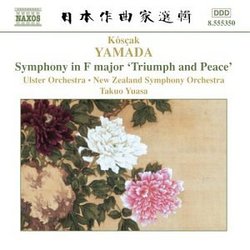| All Artists: Kosaku Yamada, Takuo Yuasa, New Zealand Symphony Orchestra, Ulster Orchestra Title: K�s�ak Yamada: Symphony in F major 'Triumph and Peace' Members Wishing: 0 Total Copies: 0 Label: Naxos Release Date: 3/16/2004 Genre: Classical Style: Symphonies Number of Discs: 1 SwapaCD Credits: 1 UPC: 747313535026 |
Search - Kosaku Yamada, Takuo Yuasa, New Zealand Symphony Orchestra :: K�s�ak Yamada: Symphony in F major 'Triumph and Peace'
 | Kosaku Yamada, Takuo Yuasa, New Zealand Symphony Orchestra K�s�ak Yamada: Symphony in F major 'Triumph and Peace' Genre: Classical
|
Larger Image |
CD Details |
CD ReviewsJapan's First-Ever Symphonic Music is Worth Hearing J Scott Morrison | Middlebury VT, USA | 04/14/2004 (4 out of 5 stars) "Kôsçak Yamada (1886-1965; the first name is as often transliterated as 'Kosaku') was Japan's first composer of Western symphonic music. By a chance of fate, he was exposed to Western military bands and Protestant hymnody in his youth. Then his sister married an Englishman, an amateur musician and organist in a local Japanese Anglican church, and he heard further Western music. Eventually he studied with a German emigré, a former student of Joseph Joachim. Finally he went to Berlin to study at the Musikhochschule in 1910. The first two pieces on this CD are student works, but are extremely skillfully done. They sound as if they could have been written by someone immersed in the music of Schubert and Mendelssohn, as indeed Yamada was. They are characterized by memorable melodies and 'correct' working-out. The 'Overture in D' and the 'Symphony in F Major' (subtitled 'Triumph and Peace') were both written in 1912. The Overture is in sonata form, although the development is given short shrift. It has a vaulting opening theme that imparts infectious forward motion to the piece. The second theme is soft and détaché and just slightly chromatic. The opening theme returns to bring the whole thing to a brashly optimistic finish.The Symphony, in four movements, opens with a catchy melody that returns in varied form in the last movement. There are both martial and hymnic themes throughout, uniting Yamada's earliest memories of Western music. Also throughout is Yamada's quotation of the Japanese national anthem ('Kimigayo') made of the descending pentatonic melody, C-A-G-F-D). The Adagio is particularly lovely and serene, reminiscent of the Adagio from Beethoven's Ninth Symphony. The Scherzo is somewhat Dvorakian and even sounds like it could have been inspired by a Central European folk-dance. The second trio of the Scherzo has a particularly lovely melody. The Finale is a strict sonata-allegro with a misterioso introduction leading to a soft brass fanfare that supplies much of the thematic material for the movement. I swear that I've heard the ensuing march theme somewhere else, but I can't place it. The 'Triumph' part of the symphony's subtitle seems apt for this movement.The final two pieces on this disc sound as if they were written by a different composer. Both 'The Dark Gate' and 'Madara No Hana' were written the year following the earlier two pieces, but it is clear that Yamada is no longer following the precepts of his Germanic teachers. Both pieces partake of the mystical thrust of Scriabin and the impressionistic harmonic features of Debussy. And the orchestration is much more creative; clearly Yamada had studied his Rimsky-Korsakov and Richard Strauss. 'Dark Gate' was inspired by a Maeterlinckian poem by Japanese poet, Rofu Miki, in which a group of blind people in a room are startled by a loud knocking on the door. They freeze, in silence, until someone begins to cry. Yamada catches the uneasiness, the silence, the quiet hysteria of the poem in this 11-minute orchestral tour de force. Interestingly, this piece was premièred in New York in 1918 with Yamada conducting the New York Symphony (one of the two precursors of the New York Philharmonic). 'Madara No Hana,' also inspired by a poem, this one by Yamada's friend Kazo Saito, is a symbolist verse about death. 'Madara No Hana' denotes "beautiful flowers growing in Buddhist Heaven." The serenely beautiful eight-minute piece is for a huge Straussian orchestra utilized amazingly skillfully by the composer, newly graduated from the Hochschule. There are two recurring intervals, a rising perfect fourth and a a falling major third. Memorable melodies and harmonic ideas abound. One is reminded to some degree of Scriabin's 'Poème de l'Extase.' The performances here are masterful. In 'Overture in D,' Takuo Yuasa conducts the New Zealand Symphony; in the others he leads the Ulster Orchestra, of which he is the Music Director. Yamada is highly honored in his native land as indeed he should be; he was not only the first Japanese composer of Western music, he also helped start what became the country's leading orchestra in Japan, the NHK Symphony Orchestra, and helped to set up music education throughout the country. His life has even been dramatized for Japanese television. [Here I must give credit to Morihide Katayama, the writer of the extremely informative booklet essay, for much of the above information about a composer I'd never encountered before.]This is a worthwhile issue, particularly for those interested in following Naxos's continuing series of Music from Japan which is opening our ears to all-but-unknown music from that country. Scott Morrison"
|

 Track Listings (7) - Disc #1
Track Listings (7) - Disc #1